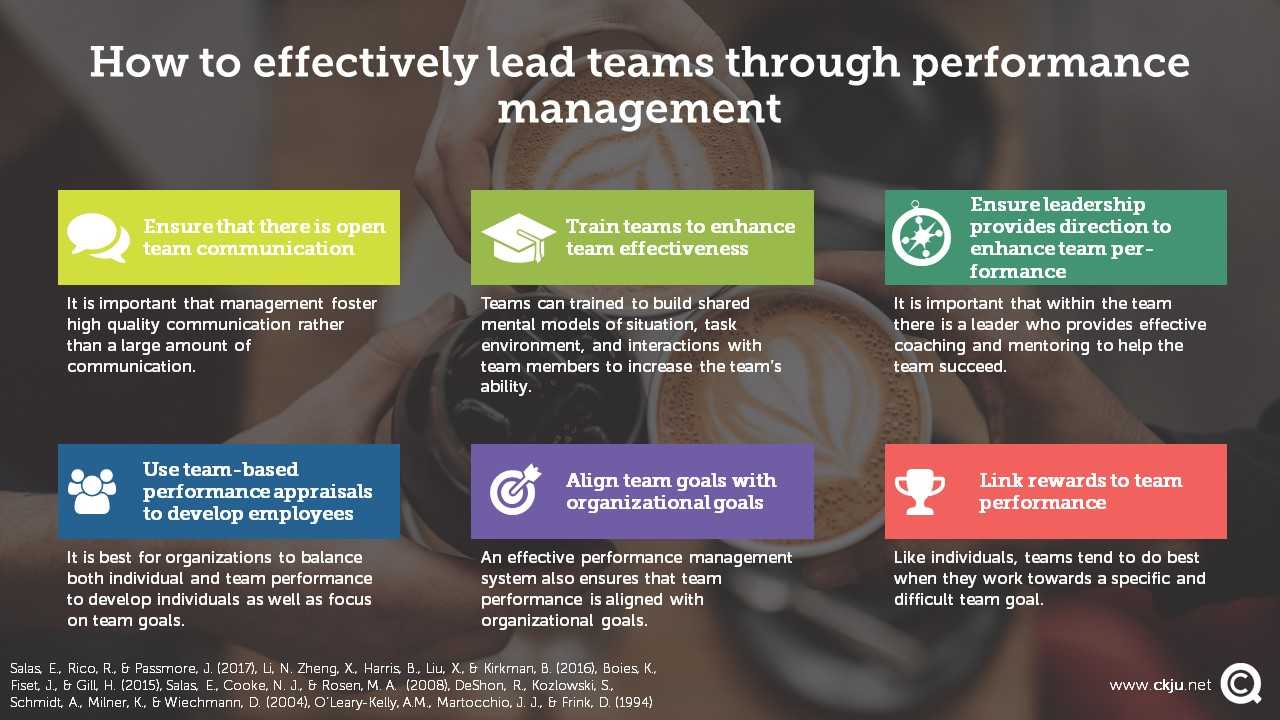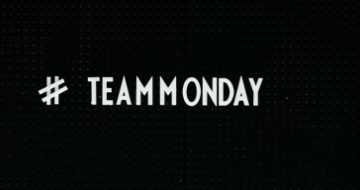- All Management Learning Resources
- Team performance management

Executive summary
This CQ Dossier focuses on how organizations can effectively manage and lead teams through effective performance management. Organizations have focused on using teams to increase organizational effectiveness, yet many of these practices have not always been based on scientific principles. Teams are social in nature with team members having high task interdependency and shared, common values (Salas, Cooke & Rosen, 2008). For teams to be effective, it is essential that organizations utilize effective performance management strategies, such as feedback, compensation and management resources, to enhance team productivity. In this Dossier, we describe several ways in which organizations can leverage team effectiveness.
Contents
- Executive summary
- Ensure that there is open team communication
- Train teams to enhance team effectiveness
- Ensure leadership provides direction to enhance team performance
- Use team-based performance appraisals to develop employees
- Align team goals with organizational goals
- Use the performance appraisal process to align team and organizational goals
- Link rewards to team performance
- Key take-aways
- References and further reading
Ensure that there is open team communication
Communication is at the heart of effective teamwork and includes communication between team members and with people outside the team (Salas, Rico & Passmore, 2017). Effective communication can greatly enhance team effectiveness and it is important that management foster high quality communication rather than a large amount of communication. It is important for organizations to allow teams to bond so that team members grow in understanding each other’s thought processes. Team cognition is important because attitudes and thoughts can influence behavior. It is important that teams are consistent regarding what they think matters and that they share the same mental models.
Train teams to enhance team effectiveness
Teams can also be trained to build team mental models of situation, task environment, and interactions with team members to increase the team’s ability to function well, particularly in stressful conditions. Team training can promote teamwork behaviors and enhance performance (Salas, Cooke & Rosen, 2008). It is important that management ensures provision of appropriate training and development happens and addresses obstacles that impeded training opportunities. Team development is a long-term process and management can facilitate individual development plans that are aligned with team objectives.
Ensure leadership provides direction to enhance team performance
It is important that within the team there is a leader who provides effective coaching and mentoring to help the team succeed. Moreoever, to raise team effectiveness, it is important that leaders empower team members to excel. Having high expectations for performance is an integral part of performance management; when team members have goals that exceed expectations this provides feedback on what is expected within the organization.
Transformational leadership
Team leadership generally refers to a leader who is able to coordinate, motivate, and assess the team performance among other teamwork enhancing tasks (Salas et al., 2017). Research has found that one of the best ways in which to provide coaching and mentoring to team members is through leaders displaying a transformational leadership style (Boies, Fiset & Gill, 2015).
Boies and colleagues (2015) conducted an experimental study whereby leaders used either inspirational motivation or intellectual stimulation to motivate team members on objective task performance or creativity. The researchers found that the leadership style – inspirational motivation or intellectual stimulation – was effective depending on the task. The results suggested that leaders using inspirational motivation obtained better task performance and that creativity was better in teams where intellectual stimulation was used (Boies et al., 2015). Accordingly, it is important to consider the style that works best in enhancing team performance based on the type of task.
Shared leadership
Shared leadership is another leadership approach that is associated with team performance improvements. The three cornerstones of shared leadership are shared purpose, social support and voice (Carson, 2007). Research indicates that teams that implement a shared leadership approach are able to better utilize the diverse knowledge, skills and ability of each team member (Chiu et al., 2016). Implementing a shared leadership approach does not necessarily mean that there is no formal team leadership in place. Team leaders can foster the three cornerstones of shared leadership and increase team effectiveness while formally leading the team (Carson et al., 2007).
Use team-based performance appraisals to develop employees
Traditionally, performance appraisals have provided information at the individual level to help enhance employee performance. However, with the growing emphasis on team work and the disappointment of traditional—based performance appraisal systems to enhance productivity, many researchers and practitioners are now focusing on more innovative performance reviews. Performance appraisal can now measure how a team of workers perform rather than just a focus on the individual.
When team work is emphasized within the organization, management can use performance appraisals to assess employee’s contribution to the team. For example, employees can be appraised on how well they work with team members (United States Office of Personnel Management). According to the US Office of Personnel Management, organizations that only recognize individual performance find that team performance suffers. It is best for organizations to balance both individual and team performance to develop individuals as well as focus on team goals.
Contextual performance which refers to the ability of employees to contribute to the overall well-being of an organization is another important performance category to consider. This especially applies for teams, because contextual performance emphasizes on whether individuals help and cooperate with others among a set of other criteria (Motowidlo & Schmit, 1999).
Align team goals with organizational goals
An effective performance management system also ensures that team performance is aligned with organizational goals. By aligning and linking team performance plans with the goals established in the organization’s performance plan, an organization is more likely to achieve its goals because each team’s efforts are channeled in the same direction as the organization. In this way, performance management can be a useful tool for clarifying team and organizational goals because the process provides benchmarks for team effectiveness.
Use the performance appraisal process to align team and organizational goals
Management and team leaders can also use the performance appraisal process to plan team and individual goals and ensure they are aligned with organizational goals. Setting a goal at the team level means that the teams must reach this goal and research finds that team goal setting improves team performance (e.g., Deshon et al., 2004). Like individuals, teams tend to do best when they work towards a specific and difficult team goal (O’Leary-Kelly et al., 1994). In a meta-analytic review of the literature, performance of teams working towards a specific and difficult group goal performed almost one standard deviation higher (d - .92) than those with ambiguous goals (O’Leary-Kelly et al., 1994).
Link rewards to team performance
In order to recognize quality performance, many organizations are using formal recognitions to publicly acknowledge when an employee has been outstanding. How can organizations do the same for team performance? Ning Li and colleagues examined whether individual achievement in teams is beneficial for the team as a whole (Li et al., 2016). They found that formally recognizing a team member led to positive changes in other team members’ individual and team performance. The research suggests that it is important to also acknowledge individual performance as well as recognizing the contributions of the team.
This CQ Dossier highlights several strategies that organizations can utilize to leverage team effectiveness. It is important that organizations formally acknowledge the importance of teams within the workplace, particularly if this is the chief way in which the organizations is organized to meet their goals. However, the research also shows that individual performance goals should not be ignored and that they can also be aligned with team goals to fulfill the organizational mission.
Key take-aways
- Be transparent and honest in communicating team expectations
- Train teams to enhance team effectiveness
- Provide direction to enhance team performance
- Use team-based performance appraisals to develop employees
- Use the performance appraisal process to align team and organizational goals
- Link rewards to team performance
Management skills newsletter
Join our monthly newsletter to receive management tips, tricks and insights directly into your inbox!
References and further reading
Boies, K., Fiset, J., & Gill, H. (2015). Communication and turst are key: Unlocking the relationship between leadership and team performance and creativity. The Leadership Quarterly, 26, 6, 1080-1094.
Carson, J. B., Tesluk, P. E., & Marrone, J. A. (2007). Shared leadership in teams: an investigation of antecedent conditions and performance. Academy of Management Journal, 50, 5, 1217-1234.
Chiu, C-Y., Owens, B.P. & Tesluk, P.E. (2016). Initiating and utilizing shared leadership in teams: The role of leader humility, team proactive personality, and team performance capability. Journal of Applied Psychology, 101, 1705-1720.
DeShon, R., Kozlowski, S., Schmidt, A., Milner, K., & Wiechmann, D. (2004). A Multiple- Goal, Multilevel Model of Feedback Effects on the Regulation of Individual and Team Performance. Journal of Applied Psychology, 89(6), 1035-1056.
Li, N. Zheng, X., Harris, B., Liu, X., & Kirkman, B. (2016). Recognizing “me” benefits “we”: Investigating the positive spillover effects of formal individual recognition in teams, 101, 7, 925-939.
Motowidlo, S. J., & Schmit, M. J. (1999). Performance assessment in unique jobs. In D. R. Ilgen & E. D. Pulakos (Eds.), The changing nature of performance (pp. 56-86). San Francisco: Jossey-Bass.
O’Leary-Kelly, A.M., Martocchio, J. J., & Frink, D. (1994). A review of the influence of group goals on group performance. Academy of Management Journal.
Salas, E., Cooke, N. J., & Rosen, M. A. (2008). "On Teams, Teamwork, as well as Team Performance: Discoveries and Developments". Human Factors: The Journal of the Human Factors and Ergonomics Society. 50 (3): 540–547.
Salas, E. Diazgranados, D., Klein, C., Shawn Burke, C. Stagl, K.C., Goodwin, G. F., Halpin, S. M. (2008). Does team training improve team performance? A meta-analysis. Human factors, 50, 6, 903-933.
Salas, E., Rico, R., & Passmore, J. (2017). The psychology of team working and collaborative processes. Wiley Blackwell: Chichester, West Sussex.
About the Author







